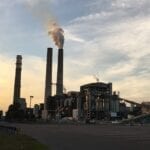Our nation’s history has been marked by the discovery of large troves of energy, harnessing that energy from nature, and then utilizing it without apprehension. Shale gas is the rising energy star of this era. With the emergence of this latest low-cost energy source, we have a chance to write a new chapter in our history – one that utilizes this fuel with care and vigilance. We have an opportunity to embrace energy efficiency as a core value in the electric production industry and make it a daily practice in our power plants.
In the past, much of the power industry’s effort, training, and experience regarding plant heat rate has been focused on coal-fired plants and with good reason: the coal plants were base loaded and represented the majority of power production in this country. But the dash to gas is bringing gas turbine technology and combined cycle plants to prominence in two ways. First is an increase in new construction. EIA estimates 26,000 MW of new natural gas power production in the U.S. by 2015. Second is a shift that has occurred in the dispatch curve where combined cycle plants are now increasingly base loaded. Now is the time for natural gas power plants to catch up to their coal-fired counterparts in the area of heat rate and thermal performance. Base load operation, higher capacity factors, and additional steady state operation provide the perfect opportunity to optimize thermal efficiency.
What are the challenges facing the natural gas fleet as it moves closer to dominance in the power market and thermal performance becomes more important?
- Compared to a similarly sized coal-fired plant, natural gas fired power plants utilize much smaller staffs. There is frequently a lack of experienced manpower available at the plant to focus on heat rate monitoring or improvement.
- Heat rate improvement, or achieving the best possible heat rate, is not required by law, not required for safe operation, nor is it required for equipment protection. Further, there is no NERC or OSHA counterpart for heat rate. Typically, resources are necessarily allocated to environmental, safety, and NERC compliance first.
- Often there are no apparent or immediate consequences for neglecting thermal performance. This is especially true for new plants operating at peak thermal performance—the return on any time or money invested for thermal performance may seem negligible or non-existent.
- As a plant ages and the thermal performance and components of the plant degrade, staff may be unaware of the extent and continuing cost of such degradation if they have not been tracking thermal performance all along. Being unaware, it is easy for the staff to continue doing what they’ve always done—neglecting thermal performance.
It isn’t difficult to justify a thermal performance tracking program for a natural gas power plant. Even with gas at $3/MMBtu the annual fuel bill for a 500 MW combined cycle plant with a 60% capacity factor will exceed $55 million. A quarter of a percent improvement in the heat rate will shave nearly $150,000 from the annual fuel bill. So in spite of some of the lowest fuel prices in the last decade and the continuing challenges that natural gas plant operators face, now is the perfect time to move your plant thermal performance off the back burner and into the core values and daily practices in place at your plant. Some considerations:
- Take advantage of higher capacity factors and additional base load operation to calculate and trend thermal performance parameters.
- Don’t try to do it all alone, especially if your staff is small and thermal performance experience is limited. There are lots of options for supporting a variety of thermal performance needs, from limited support to turnkey programs.
- Understand that the payback on thermal performance monitoring investments may take time to be realized, especially for a new, clean plant.
- Again, small improvements in thermal performance can yield six-figure gains. But don’t overlook the fact that improving thermal performance also positively impacts most major goals in power plants including availability, reliability, capacity factor, fuel costs, variable costs, emissions, and chemical usage.
- Don’t wait—the thermal performance history you build now will pay off in the future.
As the majority of U.S. power production continues to shift toward natural gas and away from coal, the natural gas fleet must move thermal performance to the forefront of its goals to ensure we utilize this inexpensive energy source wisely.









